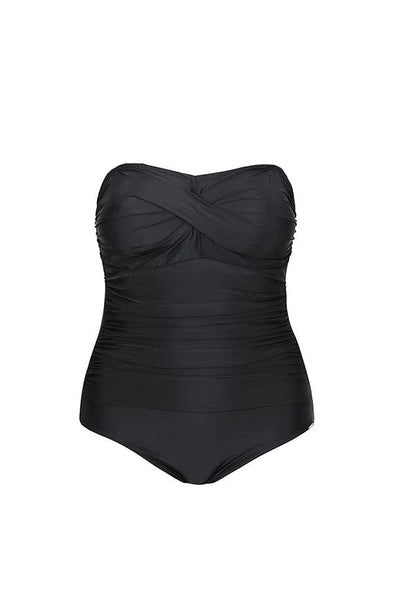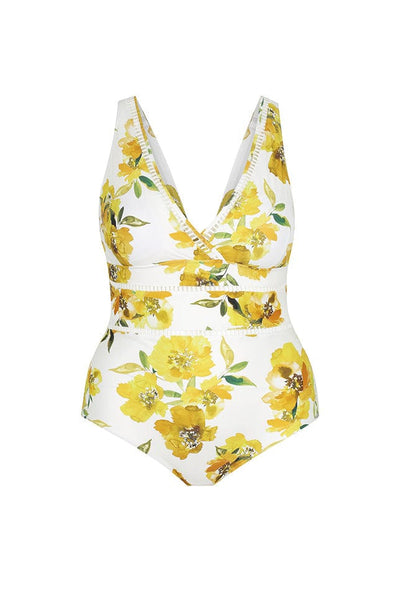Retro Swimwear Then and Now, and How To Style It!
The Return of Retro Swimwear
Retro swimwear is one of the most fashionable and glamorous trends around. With styles that flatter every body shape and a variety of vibrant colours and polka dot, gingham and floral patterns, what’s not to love?
We’re showing you retro swimsuit looks from the 30s-50s and how you can style them today!
Want to get straight into shopping? You can shop our full vintage swimwear collection here ➯
High waisted
Then: High waisted swim shorts were an essential part of bikini fashion in the 1950s. They provided the modesty that women were looking for, while also accentuating their curves and highlighting their hourglass figure.

Virginia Mayo, Image via Silver Screen Collection/Getty Images via southernliving.com
Now: The high waisted look is still incredibly popular and exudes vintage glam and elegance. Since high-waisted shorts sit at your natural waist, no matter what your body type is, they will look great. Also a great plus size retro swimwear option, they help to elongate the look of your legs, give more coverage over your tummy and back while showing off your natural figure.
Navy & White Dots Bandeau Bikini Top and High Waisted Skirted Pant
Boyleg or Skirted
Then: A boyleg or skirted style swimsuit was a classic look n the 1950s. Boyleg swimsuits were modelled after playsuits and rompers and often had small pockets, cuffs, piping trim or ruffles. Skirted swimsuits were a variation of this, with a very tight skirt at the bottom and a sweetheart neckline.

1950s model, Image via graceandface.tumblr.com
Now: Boyleg cut and skirted swimsuits are a great way to give yourself additional coverage, while also being stylish and trendy. While they are still popular as one-piece swimsuits, they’re also being worn as a bikini bottom. They are often high waisted, giving them a flattering look and tummy control while showing off your legs and upper torso.
Swim Dress
Then: A modest style of swimwear, swim dresses featured a square, v-neck or halter neckline and a circle skirt that hung loosely around the hips. It was technically a two-piece bathing suit as panties or bloomer shorts were worn underneath. The majority of swim dresses included decorative trim at the bust line to try and keep attention there and not below.

1940s model, Image via glamourdaze.com
Now: The modern swim dress is ideal if you’re after a more flowy and fuller coverage look. Like the ones from the 40s, many swim dresses include a decorative feature around or underneath the bust to accentuate the top half. Some also include underwire or removable pads to offer support and often have a built in bikini bottom underneath.
Retro Necklines - Halter and Sweetheart
Then: While there were a variety of different retro necklines they all had one thing in common, they didn’t show off a lot of skin. The sweetheart neckline in swimsuits came from the style in ball gowns and became popular in the late 30s. The style features a rounded cut that accentuates the bust and creates the illusion of curves. A halter style top was common in the 40s, where the straps would be tied behind the neck leaving the shoulders and back bare. A small bit of fabric was cut out below the bust to show some skin.

Image - Marilyn Monroe/Norma Jeane posing on the beach, Image via AP Photo/Julien's Auctions, Joseph Jasgur at newsfeed.time.com
Now: There are a range of different necklines for swimwear these days, with halter and sweetheart styles still well liked. Sweetheart tops can either be worn with or without the straps. When swimming, straps are often added for support and stability and removed when tanning. Halter necklines are very common with tankini tops and provide maximum support. The fabric used for halter tops is thicker in order to keep it in place.
Black Honeycomb Boyleg One Piece with Bow
Ruching and Panelling
Then: Ruching and panelling were used in the 40s to flatter women's figures, as swimsuits became tighter in this era. Ruching was used on both sides of a swimsuit, down the front or all over and stretchy accent panels were used on the stomach and sides.

Marie McDonald wearing a ‘figure moulding’ swimsuit, Image via glamourdaze.com
Now: Ruching and panelling are still a prominent part of swimsuit designs. Ruching is used to accent your waist while providing more coverage to your stomach and create a slimmer silhouette. Panelling helps to slim your waist and gives you a longer, leaner appearance by drawing in the sides of your stomach. Both features can be found in most swimwear types including bikinis, one pieces, swim dresses and rash vests.
Navy & White Dots Retro One Piece
Cover ups
Then: Beach cover ups were very popular in the 40s-50s as they offered another layer of modesty on top of swimwear. They would match the swimwear a woman was wearing and would be worn to the beach and pool. Cover ups were made from cotton and had a belt tied around the waist like a robe. They could also be buttoned up at the neck and flared at the thigh and have a collar or even pockets.

Printed Patten of a beach coverup, Image via Jet Set Sewing
Now: Beach cover ups are vastly different to the style in the 40s and 50s. Today they are more free flowing like a kaftan or oversized t-shirt. While they are worn to the beach as a cover up, they are also worn to casual activities afterwards like dinner or shopping. While not exactly the same, if you’re still wanting to achieve a retro look, a modern cover up can definitely help.
Cotton Beach Over Shirt in White
The great thing about retro swimwear is that it’s great for all occasions, whether you’re swimming or lounging on the beach or by the pool. Try adding a wide-brimmed hat, cat-eye sunglasses or a chic pair of sandals to create a stylish retro look!









































Leave a comment